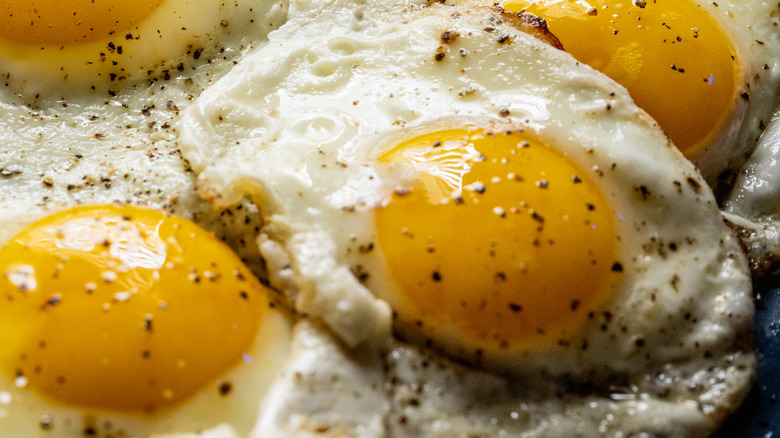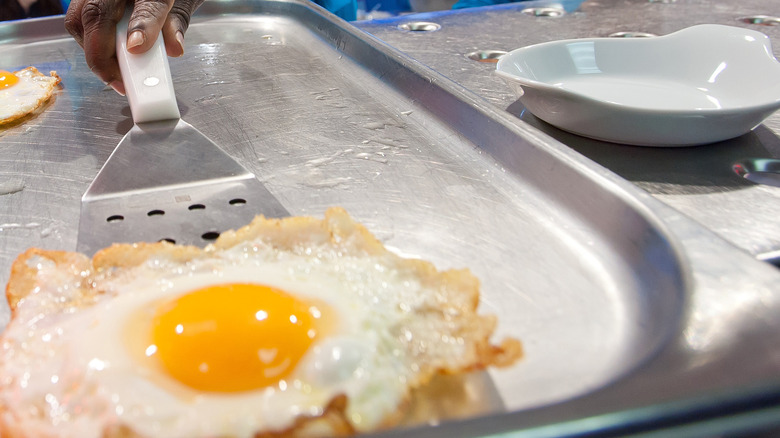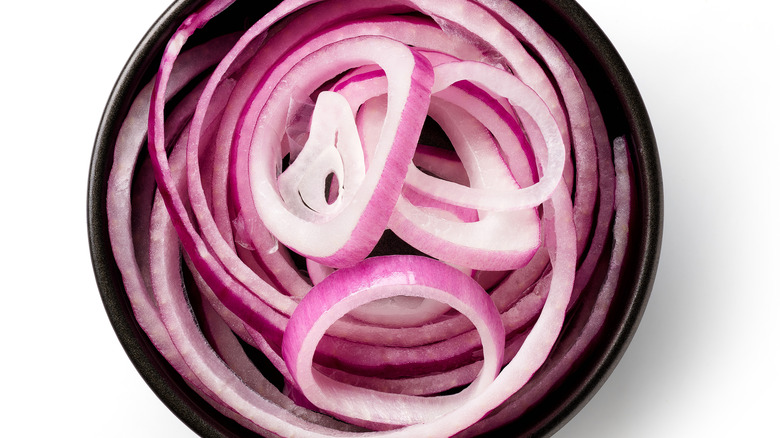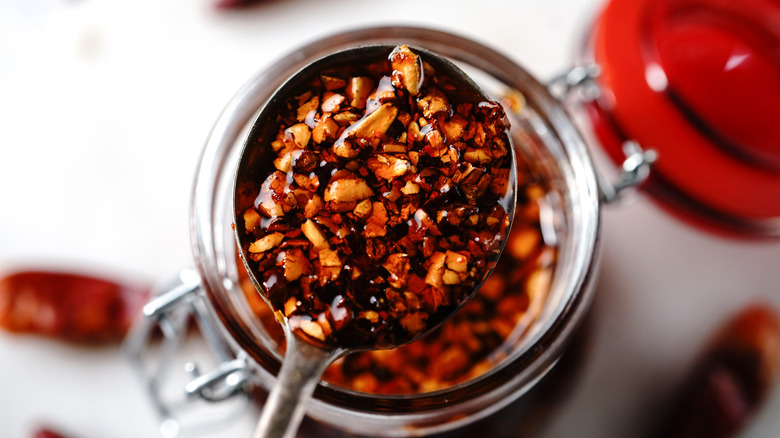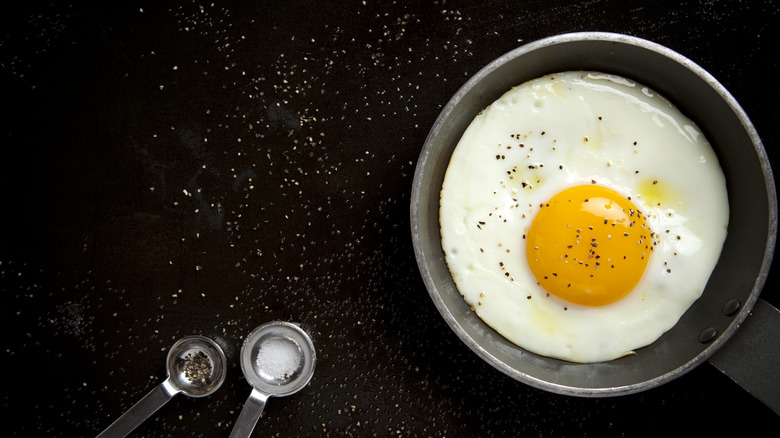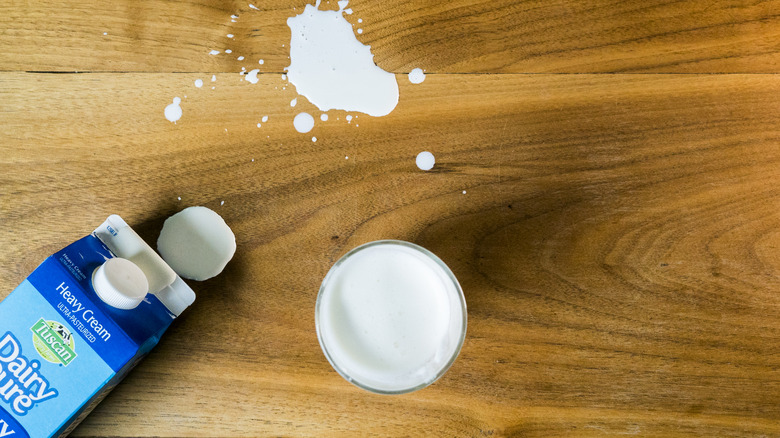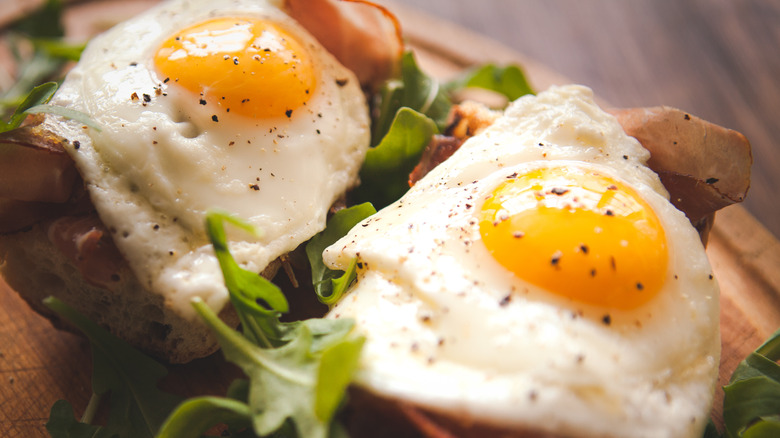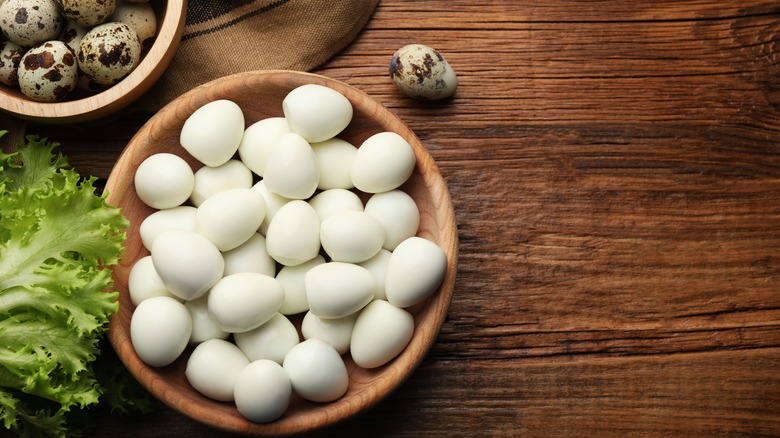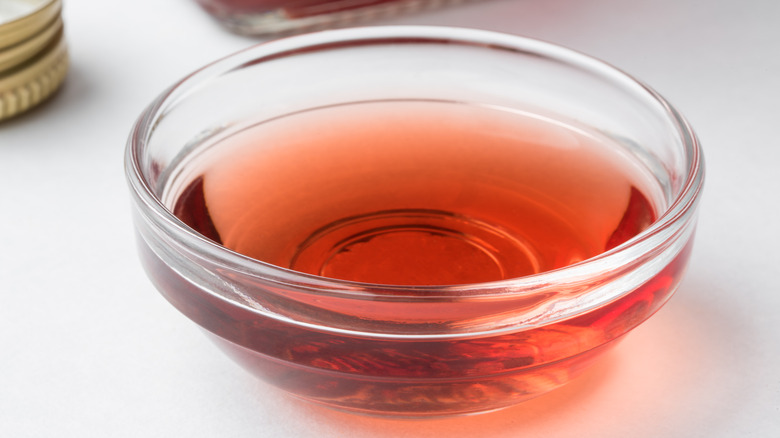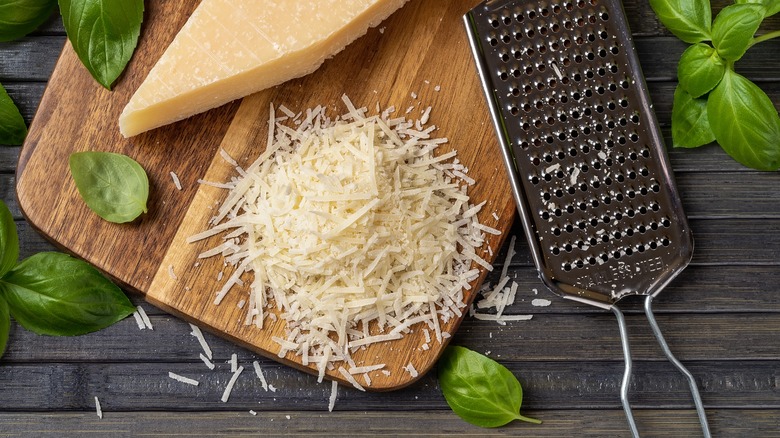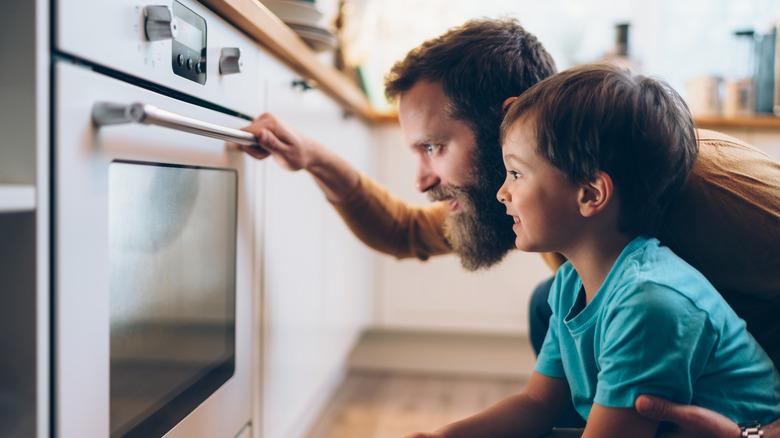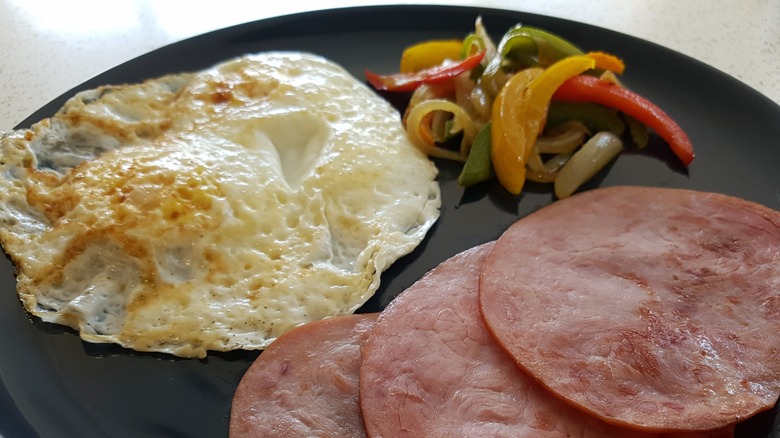Fried Egg Hacks You'll Wish You Knew Sooner
Fried eggs are one of the first things most home cooks learn to make — but it's a dish that not many fully master. This is because eggs can be unpredictable and finicky: Depending on the eggs and equipment you're using, the very steps that yield a perfect fried egg on one occasion can result in a stuck, broken, or slimy mess the next. Cooking eggs to perfection can be a mystery.
But most of us muddle through batch after batch, usually getting good-enough results. And we have a major advantage — there's no single platonic idea of a perfect fried egg, so unless you blatantly screw up (say, by burning the egg or accidentally flipping it onto the floor), whatever egg you fry is bound to be someone's idea of perfection. Fried eggs with browned, crispy edges and soft, barely cooked ones both have vocal champions, as do fried eggs with runny yolks and those fried hard. If you want to ensure they come out the way you like them every time, however, stop guessing and develop a few simple techniques.
Use a hot, lubricated pan to prevent sticking
One of the worst-case scenarios when frying eggs is the possibility of them sticking to the pan. And there's good reason for worry: Once an egg decides to stick, it's a battle to unstick it and get it out of the pan intact. There's a reason bakers use beaten egg to hold pastries together – it's a powerful natural glue. If you've ever had to scrape cooked-on egg residue from a pan, you understand how effectively eggs can hold onto a surface, whether you want them to or not.
To ensure your fried eggs don't stick, the easiest bet is using a nonstick pan. But even if you don't have one, you can take steps to ensure your eggs easily slide out of the pan when they're done. The first step is to have enough cooking fat or oil in the pan — this will form a slippery buffer between the egg and the pan's surface. The second step is to ensure the pan is good and hot when you add the egg — it should be hot enough to cause a drop of water to sizzle if splashed into the pan.
For lacy, crispy edges, baste the eggs' edges with hot oil
Individual tastes in fried eggs can be as varied as the ways the eggs turn out. For some food lovers, fried eggs with deeply browned edges are the ideal, offering a flavorful set of contrasts between the crunchy edges, firm but tender white, and rich yolk. But for others, any sign of color on the edge of a fried is a grievous error: For them, a proper fried egg should look like an illustration in a children's book, a perfectly white orb with a sunny round yolk in the middle.
For those who consider crispy edges a mandatory feature rather than a flaw, here are a few tips to ensure you get them every time. First, heat a pan to medium high and add 2 tablespoons of oil. When the oil is almost (but not quite) smoking, slip in the eggs and season with salt and pepper. Tilt the pan so the oil pools on one side of the pan and spoon the hot oil over egg whites to cook them. (Avoid pouring it over the yolk if you want to keep it runny.) Cook for about 45 seconds, until the eggs puff and are attractively browned at their edges.
Use onion rings
Fried eggs are a homy and casual dish, so most of the time, neither cooks nor eaters give a second thought if they turn out shaped more like amoebas than actual eggs. But sometimes it's nice to make them a bit more refined — and for that, cooks often rely on egg rings. Here's how to do it: Place the rings in the frying pan, crack an egg into each, and you'll end up with perfectly round fried eggs. These can be nice for special occasions or if you want eggs that will fit perfectly atop an English muffin.
To get the same polished, round shape without egg rings — and with a bit of extra flavor — use rings of cut onion instead. To make onion egg rings, peel a large onion and cut it crosswise into slices, which will each yield a number of rings. Choose bigger rings and press them firmly into the heated cooking oil in the frying pan (this will ensure no egg white slips out from under the rings). Crack the eggs into the rings and fry to your desired degree of doneness. You can either gently cut the eggs free from the rings before serving or leave them on for extra flavor and visual appeal. Simple, right?
Fry eggs in chile crisp to add crunch and flavor
A simple way to vary the flavor of fried eggs is to change up the frying medium. While neutral oils such as canola are always dependable choices, substituting more flavorful fats such as butter, extra-virgin olive oil, bacon fat, or even chorizo fat is an easy way to make a basic fried egg taste like a completely different dish. And some cooks have found that infusing neutral cooking oils with spices such as paprika can imbue a hit of flavor as well as attractive color.
Chile crisp is a flavor punch and also adds texture – it's a condiment of crunchy bits of fried garlic, onions, chiles, and other spices infused in hot chile oil. To fry eggs in chile crisp, just heat a 3 tablespoons of chile crisp in a nonstick pan over medium-high heat and slip in some eggs when it's hot. Add a splash of toasted sesame oil and cook until the eggs are done to your taste. Garnish with chopped scallions and furikake seasoning and serve over rice or toast. It's a super-fast and easy way to elevate a simple fried egg into a main-dish attraction.
Add water for fried eggs with tender, uncolored whites
A cruel irony of fried-egg cookery is that the style of egg you want is often the most elusive. Those who crave crispy, browned edges on their eggs have to settle for pale, soft eggs, while those striving for tender, pale whites find themselves vexed by unwelcome brown edges. If you fall into the latter category, have no fear: There's a foolproof way to ensure you get the egg you want every time.
And the secret ingredient to lily-white eggs is nothing more than hot tap water. To fry eggs with uncolored edges and tender whites, start them off as usual in oil in a heated pan. After about 30 seconds, add about 1/3 cup of hot water (assuming you're using a large frying pan) and continue to cook, basting the tops of the whites with the water to gently cook them until they're done to your taste. This is basically a fast hybrid between frying and poaching — less greasy and messy than regular frying, but faster and less fussy than straight poaching.
Add buttery, toasty richness by frying eggs in cream
For an elegant brunch or intimate winter supper, few things can be more welcoming than a tender cooked egg accompanied by a rich, creamy sauce — think eggs Benedict or any of its many relatives. But many of these dishes, including eggs Benedict, are notoriously fussy to make, especially for a crowd, since they require multiple components that need to be cooked (but not overcooked), kept warm, and assembled all at once. If the thought of poaching a bunch of eggs to perfection while trying to ensure your homemade hollandaise sauce doesn't curdle is your idea of hell, you're in good company.
Luckily, there's a simple way to get the same decadent eggs-in-fancy-sauce vibe using a single pan – frying eggs in cream. And the technique is pretty much like frying eggs in any other fat: Cover the bottom of a nonstick frying pan with a thin layer of heavy cream, season with salt (and other flavorings if you like), slip in your eggs, then heat the pan to medium high. The cream will bubble and start to separate into butter and milk solids; this is expected. When the whites have mostly set, cover the pan, take it off the heat, and let the eggs sit for a minute or two to ensure the tops of the whites are fully cooked. Your buttery, self-sauced fried eggs are ready to serve.
Here's how to get firm whites while keeping the yolk runny
Fried-egg lovers have very definite opinions about what constitutes a perfectly cooked yolk. For some, the ideal is barely warm and liquid, perfect for dunking a bite of hash browns or a corner of toast. For others, the yolk must be cooked solid, the better for placement in a breakfast sandwich. But pretty much everyone can agree that the white must be cooked through completely. Opinions may differ as to whether the ideal white is just-cooked and tender or sturdy with a nice bite — however, nobody wants slimy, wet whites with their fried eggs.
Fans of eggs fried hard have it easy — all they have to do is fry the heck out of their eggs and they're good to go. On the other hand, runny-yolk lovers face a challenge: How do you ensure your whites are fully cooked without overcooking the yolks, especially if you also enjoy crisp-edged, super fried whites? A fail-safe, but labor-intensive and fussy method is to separate the eggs, fry the whites until almost done, and plop the yolks on top near the end of cooking, giving them just enough time to warm through. An easier method is to cover your pan for first half the cooking period (about a minute and a half) to ensure the tops of the whites (where undercooked areas tend to persist) get fully cooked.
Use room temperature eggs to ensure even frying
Serious food nerds will tell you that consistency is everything when it comes to cooking eggs. In baking, the size of your eggs matter – and when cooking eggs as the main attraction, cooks need to be mindful that fresh eggs behave differently than older ones. But another, often overlooked factor can also contribute to the success or failure of egg dishes, including fried eggs: the temperature of the eggs when you start to cook them. If you've used the exact same methods to make your fried eggs since forever but find yourself getting wildly varied results, it could be because some batches were made with warmer or colder eggs than others.
For the best results when frying eggs, experts recommend you start with room temperature eggs. For one, they cook faster and more evenly than cold-from-the-refrigerator eggs. And for those who prefer their fried eggs with runny yolks, room temperature eggs will allow you to cook up the whites of your eggs faster, before the yolks have a chance to overcook and get hard. But if you've always relied on fried eggs as a go-to last-minute meal, don't let this stop you — to bring refrigerated eggs up to room temperature quickly, just put them in a bowl of warm (not hot) water for five minutes, and you'll be good to go.
Add a splash of vinegar for a simple twist
Part of the appeal of fried eggs is their simplicity. They're not only fast to make, but delicious when eaten with nothing more than salt and pepper. And they play so well with other foods that they show up as a sunny topper for dishes around the world, from the Korean rice dish bibimbap to Mexican huevos rancheros and more.
Occasionally, however, you want something a little more interesting than a basic fried egg but don't have the time or ingredients to do anything fancy. A couple dashes of hot sauce adds an extra pop of flavor and tartness to your eggs. For a similar (but unexpected) contrast of flavors, top your fried eggs with another ingredient: wine vinegar. A favorite late-night snack of chef Roger Vergé, this preparation involves nothing more than frying eggs in butter, slipping them onto a heated plate, then quickly reducing a few spoonfuls of wine vinegar in the butter remaining in the frying pan and pouring it over the eggs. This mixture serves as a flavorful warm vinaigrette for your eggs, and is a simple way to make them memorable.
To add extra crunch and flavor, fry eggs on shredded Parmesan
Fried eggs are among the most versatile and riff-able of foods: Creative cooks develop clever ways to refresh the familiar favorite, often just by adding an extra ingredient or two. And even better, these fried egg variations boost flavor, color, and texture — with minimal effort.
A case in point is parmesan-fried eggs, a tasty and surprising preparation in which sunny-side-up eggs are fried atop a thin layer of shredded parmesan cheese. The cheese melts and becomes a golden, crispy, savory crust at the bottom of the eggs. To make it, start with a nonstick skillet, swirl in a film of olive oil and 1/2 cup of shredded parmesan, and heat over medium until the cheese melts. Slide in the eggs and cover the pan until they start to set. Remove the cover and raise the heat to toast the cheese and finish cooking the eggs. (If the cheese browns before the eggs are ready, turn down the heat.) Transfer to serving plates and enjoy the combo of tender, creamy eggs and their salty, crunchy cheese crust.
Cooking for a crowd? Fry your eggs in the oven
While fried eggs are fast to make and almost everyone likes them, they're a pain to cook for a crowd — by the time you crack the last egg into the pan, the first eggs will be ready to serve. And even if you have easygoing guests who don't mind waiting their turn for an egg, you'll be stuck at the stove monitoring and serving them all. But if you want to treat a crowd of friends and family to fried eggs and still get to enjoy the breakfast festivities yourself, you can — by making fried eggs in the oven.
Okay, so they're technically baked, not fried. But they look and eat like fried eggs and go just as well with bacon and toast, and that's all that really counts. To make them, preheat a generously greased sheet pan in a 425 degree Fahrenheit oven. While it's heating, break 12 eggs (or fewer) into a pitcher or measuring cup, taking care not to break the yolks. When the sheet pan is hot, remove it from the oven and gently pour in the eggs. Season with salt and pepper and bake until they're cooked to your taste. For firm whites and still-runny yolks, baking will take about 15 minutes.
Flip eggs without breaking them
If you prefer your fried eggs flipped — that is, over easy or over hard — you've probably encountered the problem of yolks breaking and leaking when you try to flip your eggs. Not only do you end up losing (or overcooking) a lot of the yolks, you end up with a messy-looking bunch of eggs. They're still perfectly edible, of course, but not something you'd be proud to serve your guests.
You can end this problem by using a tool you probably already have at your side – the lid of your frying pan. Start frying your eggs in oil or fat as usual. Then add 2 tablespoons of water to the pan (pour the water around, not on, the eggs), then cover the pan with the lid. The water will steam in the pan, cooking the tops of the eggs and allowing a layer of cooked egg to develop on top of the yolk. This will give you the cooked-all-around effect of a flipped egg without requiring you to touch a spatula.

